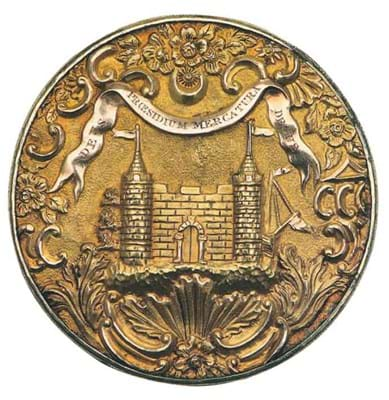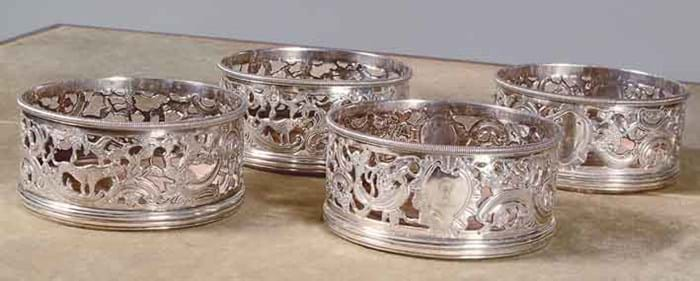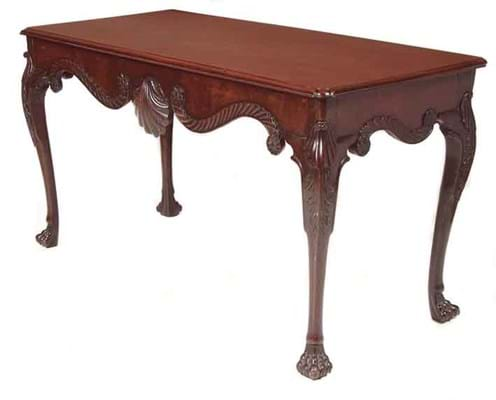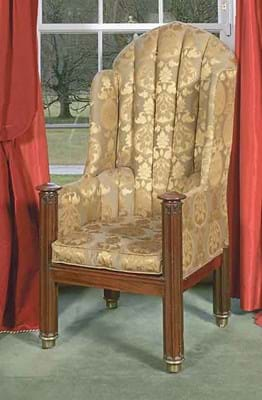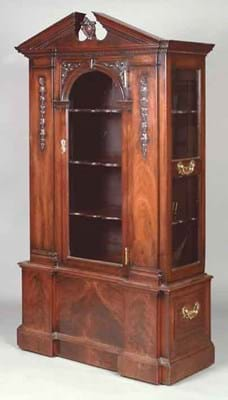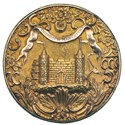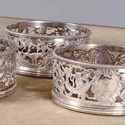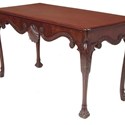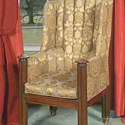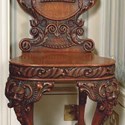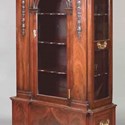This white-painted shooting lodge in the gothic style set in 5000 acres of the Wicklow Hills was built between 1787 and 1805 by members of the Huguenot banking family, the La Touches. However, in more recent years it has become synonymous with a very Irish dynasty.
Many of the 2000 people who journeyed to the Wicklow National Park late last month (and the 300 bidders who braved Mealy's marquees on a very wet Wicklow day on May 2), were lured not just by 400 lots of estate furnishings but by Guinness.
Luggala's reputation as what rock singer Bono has called "the epicentre of Irish culture", dates from 1936 and the wedding of the 4th Lord Oranmore and Browne and Oonagh Guinness.
Lady Oranmore and Browne, as she became, was given the lodge by her father and chose it as both a family retreat and a welcoming place for Irish poets, writers and musicians. The eldest of her three sons continued to foster the artistic ambience.
The Hon Garech Browne is the pony-tailed squire, a champion of traditional Irish music through his label Claddagh Records and an all round mixer in bohemian circles. But he is also a pioneering and knowledgeable collector of Irish paintings, furniture and silver. This was not so much a contents sale as an excess contents sale.
Many of the works on offer had been acquired over half a century of collecting, or had belonged to his late mother. Some had been in store since the old family home in Woodtown, Co. Dublin was sold in 1996. Some has made way for the indoor swimming pool and gothic library that were part of a recent £5m refurbishment that will raise the profile of Luggala as a deluxe corporate venue. It all made for perhaps the best Irish house sale for close to a decade.
Parting with 'the family silver' evidently proved difficult for Garech Browne. As Mealy's sale approached, he was - as vendors often do - given to changing his mind. This meant a handful of withdrawn lots (including two late 18th century Claddagh rings) and the raising of reserves to prohibitive heights on three items.
One obviously favourite item was Louis Le Brocquy's Head and Hands of Francis Bacon. Mr Browne knew both men and played an important role in securing Francis Bacon's studio, for the Hugh Lane Municipal Gallery in Dublin. Although it appeared in the catalogue with an estimate of €100,000-150,000, the reserve was shifted much higher and the auctioneer declared no sale when bidding stopped at €320,000 (£235,580).
It was not until the final viewing days that Mr Browne agreed a reserve for the so-called Francis Johnston- Speaker Clock. This monumental mahogany longcase had stood in the old Irish Parliament House on College Green, Dublin until its abolition in 1803. It was later acquired by the architect Francis Johnson, who added both his coat of arms to a rococo case c.1760 already drowning in hanging wreaths, trellis and caryatids and a carillon or musical movement of 15 graduating steel bells and 30 hammers. Bidding reached €420,000 (£306,570) but it was not enough for a sale.
However, a post-sale agreement is being negotiated at something close to this sum that will take the overall total for the dispersal to over €3m (£2.19m).
Furniture
There remains tremendous interest in Irish country house furniture, both within the local economy, where people still have money to spend, and among Irish emigrés in America. Adding to a roster of impressive sums recently chalked up for Irish mahogany furniture was the €180,000 (£131,390) bid for a side table from the 1760s estimated at €80,000- 100,000.
Standing 4ft 9in wide x 2ft 3in deep (1.45m x 67cm), it lacked the riotous apron carving associated with the most developed Gallic rococo and instead employed simple S-scrolls around a central shell - a feature repeated to the sides. It was also a very attractive colour and, like most of the furniture for sale, was in the sort of unrestored condition that serious collectors and dealers are happy to pay for.
The names of many of the great Irish 18th century houses are associated with the furniture at Luggala.
From Lissadell House in Co. Sligo was a pair of George IV straight-back, upholstered mahogany sofas in newly covered striped beige fabric.
This pair (possibly by leading Dublin cabinetmakers Williams & Gibton who made much of the furniture at Lissadell) was sold in the rough by Mealy's in 2002 at their saleroom in Castlecomer. Here, after refurbishment, it was sold at €24,000 (£17,520).
A humpback, mahogany-framed sofa in the Chippendale style was part of a vast set of seat furniture commissioned at various dates for Russborough, also in County Wicklow. The Russborough suite was dispersed in the early 20th century: part of it acquired for Moore Abbey and used by the opera singer Count John McCormack (1884-1945).This sofa (a much-imitated design) was probably made in the late 19th century. It made €16,000 (£11,680).
The most eye-catching English furniture entry was a Regency library chair distinctive for a high back of deep reeded upholstery and two gothic fluted columns forming the front legs and arm supports.
It was once part of the furnishings at Eaton Hall in Cheshire, the country seat of the first Earl Grosvenor which was reappointed in the gothic style by the architect William Porden (c.1755-1822) around the same time he was building the Indo-Sarenic riding school at Brighton Pavilion.
Porden furniture is rare - and this imposing design standing close to 5ft (1.52m) high is one of his more successful - but he is not a major name to conjure with. Nevertheless, the chair, bought by Mr Browne from a London dealer around 15 years ago but latterly deemed too large for the house, stormed to €42,000 (£30,660).
Clocks, Cabinets and Chairs
As if they needed to, Mealy's did a fine job promoting the sale and the traditionally strong Irish private buyers were much in evidence. An Irish longcase from the first decades of the 18th century is a rarity at auction. The example at Luggala, in a burr-maple case with seaweed and feather marquetry, was inscribed to a square brass dial for John Crampton of Dublin (master 1716-1719).
George Mealy thought it was in very fine condition and a private buyer agreed, bidding €26,000 (£18,980).
Dating from c.1760 was a 6ft 3in (1.91m) high display cabinet in the manner of William Vile which sold to a private buyer at €90,000 (£65,690), while a 16ft 1in (4.9m) wide, triple-breakfront library bookcase, one of two supplied by Gillows to the Co. Galway estate of 2nd Lord Clonbrock in 1801, sold to a hotel owner at €70,000 (£51,090). This was last seen at auction in 1976 when Christie's conducted a sale at Clonbrock House and sold this mighty example of estate furniture at £3800.
But the best-selling lot at the Luggala sale was neither Irish nor English but a superb Anglo-Indian ivory-inlaid padouk cabinet on stand. At 5ft 6in high x 3ft wide (1.68m x 93cm) it stands among the more ambitious creations made under the direction of the Dutch and English Companies at Vizigapatam on the Coromandel Coast during the second half of the 18th century.
The Hon. Garach Browne's love of Indian culture is well-known (he is married to Princess Harshad Purna Devi of Morvi in India where he spends part of each year).
But this was evidently a family piece. It had come through the line of Major General Sir Eyre Coote of Ash Hill, Co. Limerick, a fiery soldier whose campaigns against the French in India financed an estate in Hampshire and a place in the House of Commons. Its commercial fortunes were hindered by later glazing to the doors (no doubt a pair of splendid panels had been removed and sold as works of art long ago).
Nevertheless, underbid by the London trade, it sold privately at €200,000 (£145,990) - double the top estimate.
Among the later furniture in the sale was a pair of carved oak armorial hall chairs - typically Victorian and typically Irish creations profusely carved with grotesques, C-scrolls, leafage and the central figure of a leaping greyhound for the More O'Ferrall family.
They were possibly made for Sir Richard More O'Ferrall (1797-1880) who, among other things, was Lord of the Treasury, First Secretary of the Admiralty and the first civilian Governor of Malta. The estimate of €3000-5000 was a little on the generous side for such a good quality duo but the winning bid of €16,000 (£11,680) tendered by a private buyer must be close to retail.
The More O'Ferrall crest, doubtless from an earlier generation, was seen on a 12.5in (32cm) fiddle pattern gravy skimming spoon made by Dublin's Richard Sawyer in 1812. It's not a common form and sold at €2400 (£1750).
Silver
Garech Browne has an eye for Irish silver. This was not a large offering but it was much admired - many items purchased a generation or more ago from well-known dealers and in much better condition than country house life often allows.
It is rare to find a set of four Dublin wine coasters and the quartet here made by William Nolan in 1824 were sophisticated examples in the rococo taste, with galleries populated by fruiting vines, birds and hunting hounds divided by cartouches engraved with the crest of Conolly of Castletown. A clearance sale was held at the Palladian grandeur of Castletown in Co. Kildare in 1966 when the coasters were likely purchased.
At the Luggala sale they brought a strong, above-estimate €37,000 (£27,000) from a private buyer.
A pair of Dublin bottle holders by Robert Smith, 1844 were crested for Vernon of Clontarf Castle in suburban Dublin. Weighing a total of 59oz, they were profusely chased and pierced with scrolling vines and applied with a leaf and floral crest edge and conforming rococo base. They sold privately at €28,000 (£20,440) against an estimate of €12,000-18,000.
A real Victorian rarity was a silver post horn by John Smyth, Dublin, 1867. It carried the presentation inscription: Daniel McDevitt in memory of his exertions in establishing a Mail-Car between Glenties and Stranorlar from the Marquess of Conyngham, November 4, 1867. It looked very much something for an institution and it went to the National Museum in Dublin at €24,000 (£17,520).
Dublin silver dealers J.W. Weldon bought a very fine and historically interesting 5oz silver gilt freedom box by Wests at an upper-estimate €20,000 (£14,600). Superbly chased in relief with the arms of Drogheda to the front and engraved with the arms of Lieutenant General Sir Galbraith Lowry Cole to the reverse, it was inscribed: The Freedom of the Ancient Corporation of Drogheda and this Box were unanimously voted to Lieut. General Sir Galbraith Lowry Cole G.C.B., a gallant associate of The Illustrious Wellington. A Sincere Tribute of Respect Admiration, Drogheda 7th October 1814.
Another piece of desirable Irish silver was a bright-cut ladle for salad oil carrying the rare mark for Limerick smith Maurice Fitzgerald, 1784, It measured just 4in (10cm) long but took a remarkable €2800 (£1600).
The choice English silver entries were two attractively pitched, London-made late Victorian novelties.
Sold at a ten-times estimate €3600 (£2055) was a 2.75in (7cm) vesta stand in the form of a chimpanzee holding a barrel, while €5000 (£3650) was bid against similar expectations for a 21/2in x 31/2in (6.5cm x 9cm) mustard pot modelled as a monkey pushing a coopered circular barrel. Both were bought by the London trade. Eighteenth century rosary beads (many of them were made in Galway) are a rare sight at auction and much collected in Catholic Ireland.
There were two strings here: each with a silver crucifix with attached I.N.R.I., and original Corpus Christi, one with silver paters and hardwood aves, the other with mother-of-pearl aves. They sold at €3600 (£2630) and €3000 £2190) respectively.
Exchange rate £1 =€1.37
20% buyer's premium inc VAT

